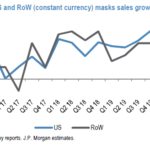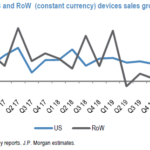Current Price: $1,257 Price Target: $1,350
Position Size: 4.7% TTM Performance: +18%
Alphabet reported mixed results, beating on the top line and missing on EPS. Revenue growth was +22% ($40.5B vs. consensus of $40.3B) driven by better than expected ad revenue. Net advertising revenue totaled $26.4B compared to consensus at $26.3B. While some cost pressures moderated, they also had some one-time hits that impacted earnings including a $1.5B unrealized loss on investments in other companies. They are an active venture capital investor (Capital G), but didn’t say which investments contributed to the loss. They also took a hit from a $554 million legal settlement in France. TAC as a percent of revenue decreased and capex was lower than expected. Reuters reported yesterday that Google made an offer to buy Fitbit, sending Fitbit shares up 30% yesterday, but mgmt. wouldn’t comment about this on the call.
Key takeaways:
· Interestingly, they’ve recently been evolving the way they talk about their mission. They used to say it was to “organize the world’s information” – now they say, “we’ve evolved from a company that helps people find answers to a company that helps you get things done.” Shift suggests growing focus on cloud, AI and hardware.
· Two significant technology advances:
1. “Dramatic improvement” in their search algorithm b/c of a new type of neural network based technique called BERT. Here’s an article about it: https://techcrunch.com/2019/10/25/google-brings-in-bert-to-improve-its-search-results/
2. Quantum supremacy – Google’s 53-qubit quantum machine, Sycamore, successfully performed a test computation in just 200 seconds that would have taken the most powerful supercomputers many years to accomplish. “Distinct milestone in our effort to harness the principles of quantum mechanics to solve computational problems.” For anyone who is interested, you can learn more about this here: https://www.ft.com/video/48d44362-3926-4111-b19b-037c0394a85c?emailId=5db6d71006676700047a9d10&segmentId=13b7e341-ed02-2b53-e8c0-d9cb59be8b3b&playlist-name=editors-picks&playlist-offset=4
· Top growth drivers were mobile search, YouTube and cloud.
· Key expense lines:
o Higher cost of revenues as a % of sales driven by costs associated with data centers including depreciation, content acquisition costs (primarily for YouTube), and impact of Pixel 3a hardware costs, offset by lower % of TAC.
o Higher than expected opex driven by legal settlement in France. Headcount is also key driver in opex increases. Sizable headcount increase focused on cloud business.
· Google Other Revenues (includes Google Play, Google Cloud, and Hardware)
o $6.4B in revenue vs consensus of $6.3B, up +39% YoY.
o Cloud: No specific detail on cloud. Last quarter they indicated it was at an $8B run-rate. Google had a change in leadership in their cloud business earlier this year and is looking to triple their cloud division sales force over the next few years.
o Announced partnership with Mayo Clinic – they will us Google Cloud to secure and store data and understand insights at scale. The partnership will encompass transforming patient and clinician experiences, identifying new methods of diagnosing diseases, conducting clinical research and finding new models for delivering patient care.
o Hardware:
§ They have long talked about hardware as a growth priority for them.
§ Hardware benefited from the Pixel 3a – their lower priced phone. The phone did a lot better than the more expensive Pixel 3.
§ New products…Nest mini, Pixelbook Go, Pixel 4 and Pixel Buds, similar to air pods.
o Gaming: Stadia, their streaming video game business, will soon be available in the US, UK, Canada, and throughout Europe.
· Other Bets: Waymo continues to progress…expanding in Phoenix and testing long-haul truck driving on Arizona freeways. There will also be heavy-rain testing in Florida and 3-D mapping in Los Angeles.
· Record High Share buybacks – $5.7B in Q3 which brings buybacks to $12.3B YTD. $121B of cash & equivalents on the balance sheet.
Valuation:
· Reasonable valued, trading at >4% FCF yield on 2020.
· $107B in net cash, ~13% of their market cap.
$GOOGL.US
[tag GOOGL]
Sarah Kanwal
Equity Analyst, Director
Direct: 617.226.0022
Fax: 617.523.8118
Crestwood Advisors
One Liberty Square, Suite 500
Boston, MA 02109
www.crestwoodadvisors.com


